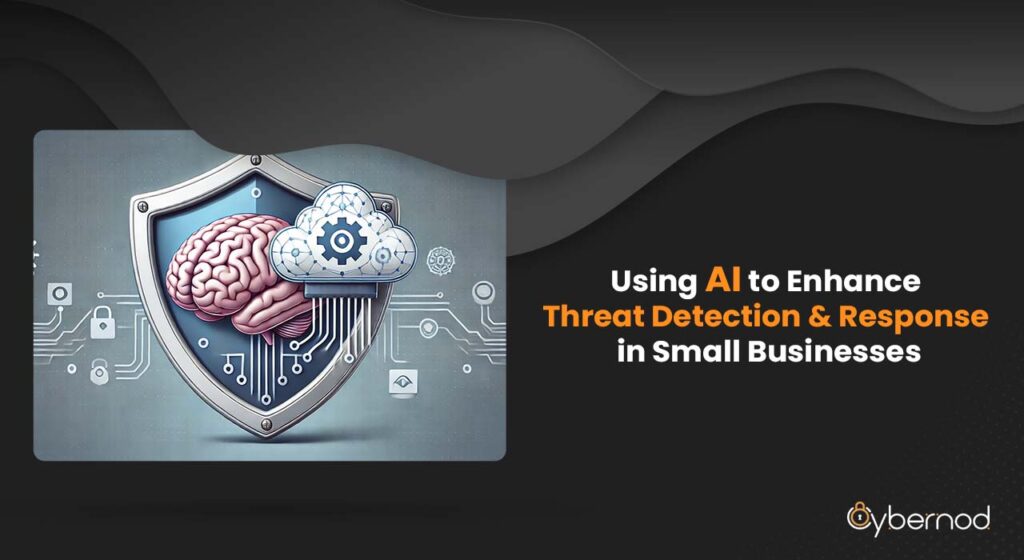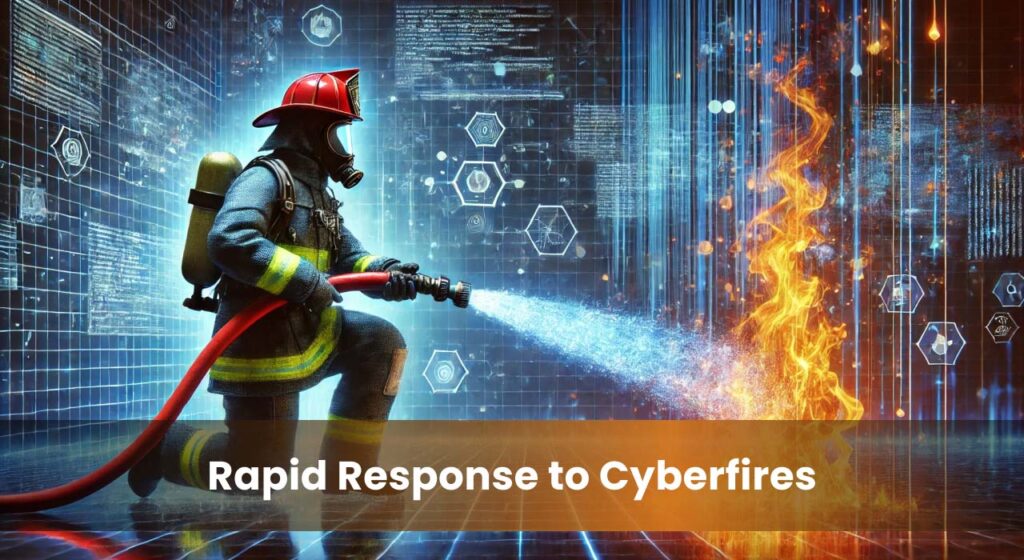
Cybersecurity, the practice of protecting computer systems and networks from digital attacks, has become an imperative for businesses of all sizes. For small enterprises, the stakes are particularly high. With limited resources and often a smaller IT staff, these organizations are particularly vulnerable to cyber threats. The cyber threat landscape is evolving rapidly, with increasingly sophisticated attacks targeting businesses of all scales. From ransomware attacks crippling operations to data breaches compromising sensitive customer information, the consequences can be devastating.
Artificial intelligence (AI) offers a promising avenue for bolstering cybersecurity defenses. By leveraging advanced algorithms and machine learning, AI systems can analyze vast amounts of data to identify potential threats, predict attack patterns, and respond to incidents swiftly. Through automation and enhanced threat detection, AI has the potential to significantly enhance threat detection and response capabilities for small businesses, providing a robust defense against cyberattacks.
The Cyber Threat Landscape for Small Businesses

Small businesses constitute a significant portion of the global economy, yet they often find themselves disproportionately vulnerable to cyberattacks. Common threats targeting these enterprises include ransomware, phishing, and data breaches. Ransomware, a type of malicious software that encrypts a victim’s files, has become a prevalent tactic used by cybercriminals to extort money from businesses. Phishing attacks, designed to deceive individuals into revealing sensitive information, pose a constant threat to employee credentials and corporate data. Data breaches, resulting in the unauthorized access and exposure of confidential information, can have severe financial and reputational consequences.
The repercussions of a cyberattack can be catastrophic for small businesses. Beyond the immediate financial losses incurred from ransom payments, system repairs, and lost productivity, the reputational damage can be long-lasting. Customers may lose trust in a business compromised by a data breach, leading to a decline in sales and market share. Moreover, regulatory fines and legal liabilities can further exacerbate the financial burden.
Defending against these threats presents significant challenges for small businesses. Limited IT budgets often preclude the investment in robust cybersecurity infrastructure and skilled personnel. Additionally, the rapidly evolving nature of cyber threats necessitates ongoing training and awareness programs for employees, a resource-intensive endeavor. These factors combined create a complex environment in which small businesses must operate while striving to protect their digital assets.
The Role of AI in Cybersecurity

Artificial intelligence (AI), a branch of computer science focused on creating intelligent agents, has emerged as a transformative force in various industries, including cybersecurity. At its core, AI encompasses technologies such as machine learning, natural language processing, and computer vision. Machine learning enables systems to 1 learn from data without explicit programming, while natural language processing facilitates human-computer interaction through language understanding.
Within the realm of cybersecurity, AI offers immense potential. Its ability to analyze vast datasets at unprecedented speeds allows for the identification of complex patterns and anomalies indicative of malicious activity. AI-powered systems can detect threats, such as advanced persistent threats (APTs) and zero-day vulnerabilities, which often evade traditional security measures. Furthermore, AI can automate routine tasks, such as incident response and threat hunting, freeing up human experts to focus on strategic initiatives. The result is a more efficient, accurate, and proactive cybersecurity posture.
AI-Powered Threat Detection
In the intricate landscape of cybersecurity, the ability to analyze enormous datasets effectively is paramount. AI algorithms excel in this area, sifting through network traffic, system logs, and user behavior to detect patterns indicative of malicious activity. These patterns, often subtle and beyond human perception, can signal a cyberattack in progress.
Traditional security methods, while essential, have limitations in the face of ever-evolving threats. Signature-based detection, for instance, only identifies known threats, leaving organizations vulnerable to zero-day vulnerabilities and novel attacks. Rule-based intrusion detection systems (IDS) can generate excessive false positives and negatives, requiring constant tuning and maintenance. Manual security analysis, while thorough, is time-consuming and resource-intensive, hindering an organization’s ability to respond swiftly to threats.
AI-powered threat detection offers significant advantages over these traditional methods. Here’s a table summarizing the comparison:
| Traditional Security Methods | Limitations | AI-Powered Threat Detection | Benefits |
|---|---|---|---|
| Signature-based detection | Limited to known threats | Anomaly detection | Identifies unknown threats |
| Rule-based intrusion detection systems | Prone to false positives/negatives | Behavior analytics | Reduces false positives/negatives |
| Manual security analysis | Time-consuming and resource-intensive | Machine learning | Automates analysis and improves efficiency |
Advanced Persistent Threats (APTs) and Zero-Day Vulnerabilities
AI is particularly adept at detecting advanced persistent threats (APTs). APTs are sophisticated attacks designed to infiltrate a network and remain undetected for extended periods. By continuously analyzing vast amounts of data over time, AI can uncover subtle anomalies in user behavior or network traffic that might signal the presence of an APT.
Similarly, AI is instrumental in defending against zero-day vulnerabilities, previously unknown software flaws exploited by attackers. Machine learning algorithms can be trained on historical data and continuously updated with new information. This allows them to identify deviations from normal system behavior that may indicate the exploitation of a new vulnerability, even if it has not yet been discovered and documented.
AI Techniques for Threat Identification
Several specific AI techniques are at the forefront of AI-powered threat detection:
- Anomaly detection: This technique identifies data points that deviate significantly from established patterns. In cybersecurity, anomalies may indicate suspicious activity or a potential attack.
- Behavior analytics: This technique analyzes user and system behavior to identify deviations from normal patterns. For instance, a user account accessing the network from an unusual location or at an odd time may trigger an investigation.
- Machine learning: Machine learning algorithms can be trained on vast datasets of labeled data, enabling them to recognize patterns indicative of malicious activity. Over time, these algorithms can improve their accuracy in threat detection.
By leveraging these techniques, AI empowers cybersecurity professionals to identify and mitigate threats with greater efficiency and accuracy, ultimately safeguarding valuable data and critical infrastructure.
While these methods offer a valuable foundation, for businesses seeking a more comprehensive and proactive approach to cybersecurity, Artificial Intelligence (AI) presents a transformative solution.
To explore the profound impact of AI on enhancing cybersecurity and its role in safeguarding business sustainability, refer to our follow-up article: “The Impact of Cybersecurity on Small Business Sustainability and Growth”
AI-Driven Incident Response

The speed and efficacy of incident response are paramount in mitigating the impact of cyberattacks. A swift and coordinated response can significantly reduce financial losses, reputational damage, and operational disruption. AI-powered solutions offer a transformative approach to incident response, automating key processes and enhancing decision-making.
By leveraging AI, organizations can automate routine incident response tasks, such as threat containment and eradication. For instance, AI-driven systems can automatically isolate compromised systems, block malicious IP addresses, and terminate active threats. This automation frees up security teams to focus on higher-level investigative and strategic activities. Additionally, AI can analyze vast amounts of data to identify the root cause of an incident, accelerating the remediation process.
AI-powered threat intelligence platforms play a pivotal role in understanding the evolving threat landscape. These platforms aggregate data from multiple sources, including open-source intelligence, threat feeds, and internal security data. AI algorithms analyze this information to identify emerging threats, vulnerabilities, and attack vectors. By providing actionable insights, threat intelligence platforms empower organizations to proactively address potential risks and improve their overall security posture.

By streamlining incident response processes and providing valuable insights, AI empowers organizations to build a more resilient cybersecurity posture.
Overcoming Challenges and Considerations

While AI offers immense potential for enhancing cybersecurity, its implementation within small businesses presents unique challenges. Financial constraints often limit the acquisition of advanced AI solutions and the necessary hardware infrastructure. Additionally, concerns about data privacy and security arise when handling sensitive information. Small businesses may lack the expertise to effectively manage these complexities, hindering AI adoption.
To maximize the benefits of AI while mitigating risks, a human-in-the-loop approach is essential. Human experts must oversee AI systems, validate findings, and make critical decisions. This collaborative approach guarantees that AI serves as a tool to enhance human capabilities rather than supplant them.
Furthermore, the dynamic nature of the threat landscape necessitates continuous learning and adaptation for AI models. Regular training with updated datasets is crucial to maintain AI effectiveness. By investing in ongoing education and development, organizations can ensure that their AI systems remain at the forefront of cybersecurity.
Choosing the Right AI Cybersecurity Solution
Selecting the appropriate AI-powered cybersecurity solution is crucial for small businesses seeking to enhance their defenses. Several key factors should be considered during the evaluation process. Cost-effectiveness is paramount, as solutions must align with a limited budget. Scalability is essential to accommodate future growth and evolving security needs. Furthermore, ease of use is crucial for efficient implementation and management, particularly for organizations with limited IT resources. The solution’s ability to integrate seamlessly with existing security infrastructure is also vital to optimize its effectiveness.
To make an informed decision, conducting a comprehensive security assessment is indispensable. By identifying specific vulnerabilities and security gaps, businesses can tailor their solution selection to address their unique requirements. This assessment will help determine the necessary features and functionalities, ensuring that the chosen AI cybersecurity solution effectively protects the organization’s assets.
To make an informed decision, conducting a comprehensive security assessment is indispensable. By identifying specific vulnerabilities and security gaps, businesses can tailor their solution selection to address their unique requirements. This assessment will help determine the necessary features and functionalities, ensuring that the chosen AI cybersecurity solution effectively protects the organization’s assets.
AI has emerged as a formidable tool in the ongoing battle against cyber threats. By augmenting human capabilities, AI-powered solutions can significantly enhance a small business’s cybersecurity posture. Through rapid threat detection, automated incident response, and advanced threat intelligence, AI empowers organizations to protect their valuable assets from the growing spectrum of cyberattacks. To safeguard their digital infrastructure and maintain business continuity, small businesses are strongly encouraged to invest in AI-based cybersecurity solutions.
Categorized in:
Comments